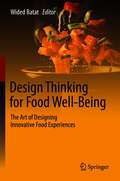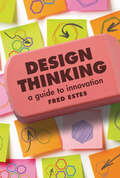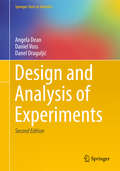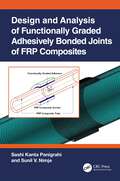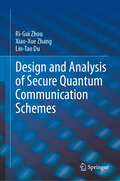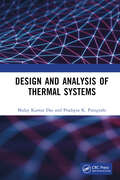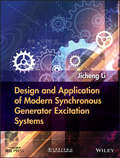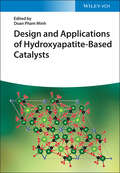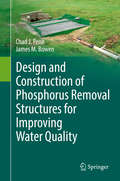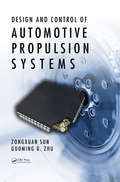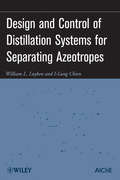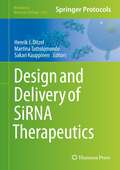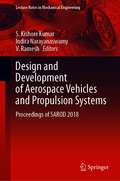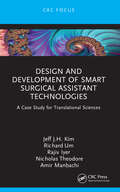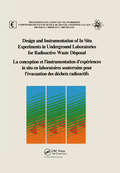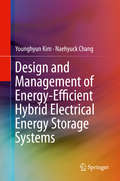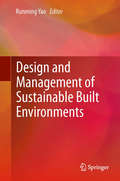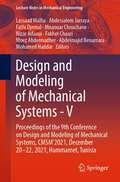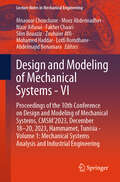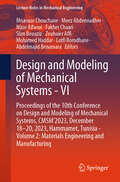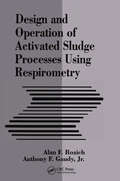- Table View
- List View
Design Thinking for Food Well-Being: The Art of Designing Innovative Food Experiences
by Wided BatatHow can we design innovative food experiences that enhance food pleasure and consumer well-being? Through a wide variety of empirical, methodological, and theoretical contributions, which examine the art of designing innovative food experiences, this edited book explores the relationship between design thinking, food experience, and food well-being. While many aspects of food innovation are focused on products' features, in this book, design thinking follows an experiential perspective to create a new food innovation design logic that integrates two aspects: consumer food well-being and the experiential pleasure of food. It integrates a holistic perspective to understand how designing innovative food experiences, instead of food products, can promote healthy and pleasurable eating behaviors among consumers and help them achieve their food well-being. Invaluable for scholars, food industry professionals, design thinkers, students, and amateurs alike, this book will define the field of food innovation for years to come.
Design Thinking: A Guide to Innovation
by Fred EstesDesign thinking is a six-step process used in creative problem solving to understand users, challenge assumptions, redefine problems, and create innovative solutions. As a human-centered approach to innovation, design thinking is used in everything from corporate structure in businesses such as UberEATS, AirBnB, and Adobe XD to local and regional projects. Design Thinking, by author and educator Fred Estes, provides a simple, clear approach to the six-step design thinking process. This easy-to-follow guide explains everything essential to design thinking projects focused on solving human-centered, social issues. Readers will learn the fundamentals of each of the six-steps in the design thinking model—notice and reflect, empathize, define, ideate, prototype, and test—and discover how to collaborate with people to develop solutions to real-world problems and create better communities through creativity, inspiration, and teamwork. With true stories of real student teams and their projects, this book provides readers with the steps to effect change and create a more equitable world.
Design and Analysis of Experiments
by Angela Dean Daniel Voss Danel DraguljićHandbook of Design and Analysis of Experiments provides a detailed overview of the tools required for the optimal design of experiments and their analyses. The handbook gives a unified treatment of a wide range of topics, covering the latest developments. This carefully edited collection of 25 chapters in seven sections synthesizes the state of the art in the theory and applications of designed experiments and their analyses. Written by leading researchers in the field, the chapters offer a balanced blend of methodology and applications. The first section presents a historical look at experimental design and the fundamental theory of parameter estimation in linear models. The second section deals with settings such as response surfaces and block designs in which the response is modeled by a linear model, the third section covers designs with multiple factors (both treatment and blocking factors), and the fourth section presents optimal designs for generalized linear models, other nonlinear models, and spatial models. The fifth section addresses issues involved in designing various computer experiments. The sixth section explores "cross-cutting" issues relevant to all experimental designs, including robustness and algorithms. The final section illustrates the application of experimental design in recently developed areas. This comprehensive handbook equips new researchers with a broad understanding of the field's numerous techniques and applications. The book is also a valuable reference for more experienced research statisticians working in engineering and manufacturing, the basic sciences, and any discipline that depends on controlled experimental investigation.
Design and Analysis of Functionally Graded Adhesively Bonded Joints of FRP Composites
by Sashi Kanta Panigrahi Sunil V. NimjeThis book provides up-to-date information relevant to the analysis and design of adhesively bonded joints made up of fiber-reinforced polymer (FRP) composites using functionally graded adhesive (FGA). Damage behaviors in adhesively bonded joints of laminated FRP composites have been addressed, and joint configurations have been modeled using special finite elements (FEs) and multipoint constraint elements to simulate the contact behavior. Detailed 3D finite element analyses (FEAs) have been presented for different adhesively bonded joint structures along with guidelines for effective design philosophy of adhesively bonded joints in laminated FRP structures using FGA. Features: Provides a thorough and systematic discussion on the functionally graded adhesive and its joints. Discusses analytical modeling and numerical analyses of the joints. Details 3D stress and failure delamination analysis for composite analyses of functionally graded out-of-plane joints under various combinations of loading. Illustrates FE modeling and simulation of interfacial failure and damage propagation in out-of-plane joints. Includes the effect of various gradation function profiles on damage growth driving forces (SERR). This book is aimed at researchers, professionals and graduate students in composites, infrastructure engineering, bonding technology and mechanical/aerospace engineering.
Design and Analysis of Long-term Ecological Monitoring Studies
by Andrew B. Cooper Robert A. Gitzen Daniel S. Licht Joshua J. MillspaughTo provide useful and meaningful information, long-term ecological programs need to implement solid and efficient statistical approaches for collecting and analyzing data. This volume provides rigorous guidance on quantitative issues in monitoring, with contributions from world experts in the field. These experts have extensive experience in teaching fundamental and advanced ideas and methods to natural resource managers, scientists and students. The chapters present a range of tools and approaches, including detailed coverage of variance component estimation and quantitative selection among alternative designs; spatially balanced sampling; sampling strategies integrating design- and model-based approaches; and advanced analytical approaches such as hierarchical and structural equation modelling. Making these tools more accessible to ecologists and other monitoring practitioners across numerous disciplines, this is a valuable resource for any professional whose work deals with ecological monitoring. Supplementary example software code is available online at www.cambridge.org/9780521191548.
Design and Analysis of Secure Quantum Communication Schemes
by Ri-Gui Zhou Xiao-Xue Zhang Lin-Tao DuThis book provides a comprehensive guide to the design and analysis of quantum secure communication schemes. While quantum computers may provide a platform for arithmetic calculations which threaten classical cryptosystems, the development of quantum information has also brought a corresponding solution: quantum cryptography, which is the basis of quantum secure communication. Quantum secure communication (QSC) uses quantum states for key agreement and information transmission, and uses the basic principles of quantum mechanics to discover eavesdropping behavior, and to ensure the security of information. It can overcome the security risks of classical encryption technology and can securely distribute keys in real time via public channels. Beginning in 1984 with the first conception of quantum key distribution (QKD) based on single-photon polarization states, subsequent innovations include quantum identity authentication (QIA), quantum secret sharing (QSS), quantum direct communication (QDC), quantum key agreement (QKA), quantum private query (QPQ), and quantum network coding (QNC). Each of these schemes is explored in detail based on different environments and structures, along with specific security and feasibility analyses. This book is essential reading for academic researchers and graduate students in quantum science and technology, as well as professionals and engineers in quantum industries and cybersecurity.
Design and Analysis of Subgroups with Biopharmaceutical Applications (Emerging Topics in Statistics and Biostatistics)
by Naitee Ting Shuyen Ho Joseph C. Cappelleri Din Ding-Geng ChenThis book provides an overview of the theories and applications on subgroups in the biopharmaceutical industry. Drawing from a range of expert perspectives in academia and industry, this collection offers an overarching dialogue about recent advances in biopharmaceutical applications, novel statistical and methodological developments, and potential future directions.The volume covers topics in subgroups in clinical trial design; subgroup identification and personalized medicine; and general issues in subgroup analyses, including regulatory ones. Included chapters present current methods, theories, and case applications in the diverse field of subgroup application and analysis. Offering timely perspectives from a range of authoritative sources, the volume is designed to have wide appeal to professionals in the pharmaceutical industry and to graduate students and researchers in academe and government.
Design and Analysis of Thermal Systems
by Malay Kumar Das Pradipta K. PanigrahiThermal systems are essential features of all domestic and industrial applications involving heat and fluid flow. Focusing on the design of thermal systems, this book bridges the gap between the theories of thermal science and design of practical thermal systems. Further, it discusses thermodynamic design principles, mathematical and CFD tools that will enable students as well as professional engineers to quickly analyze and design practical thermal systems. The major emphasis is on practical problems related to contemporary energy- and environment-related thermal systems including discussions on computational fluid dynamics used in thermal system design. Features Exclusive book integrating thermal sciences and computational approaches Covers both philosophical concepts related to systems and design, to numerical methods, to design of specific systems, to computational fluid dynamics strategies Focus on solving complex real-world thermal system design problems instead of just designing a single component or simple systems Introduces usage of statistics and machine learning methods to optimize the system Includes sample PYTHON codes, exercise problems, special projects This book is aimed at senior undergraduate/graduate students and industry professionals in mechanical engineering, thermo-fluids, HVAC, energy engineering, power engineering, chemical engineering, nuclear engineering.
Design and Application of Modern Synchronous Generator Excitation Systems
by Jicheng LiUses real world case studies to present the key technologies of design and application of the synchronous generator excitation system This book systematically introduces the important technologies of design and application of the synchronous generator excitation system, including the three-phase bridge rectifier circuit, diode rectifier for separate excitation, brushless excitation system and the static self-stimulation excitation system. It fuses discussions on specific topics and basic theories, providing a detailed description of the theories essential for synchronous generators in the analysis of excitation systems. Design and Application of Modern Synchronous Generator Excitation Systems provides a cutting-edge examination of excitation system, addressing conventional hydro-turbines, pumped storage units, steam turbines, and nuclear power units. It looks at the features and performance of the excitation system of the 700MW hydro-turbine deployed at the Three Gorges Hydropower Plant spanning the Yangtze River in China, as well as the working principle and start-up procedure of the static frequency converter (SFC) of pumped storage units. It also expounds on the composition of the excitation transformer, power rectifier, de-excitation equipment, and automatic excitation regulator—in addition to the performance features of the excitation system of conventional 600/1000MW turbines and the excitation system of the 1000MW nuclear power unit. • Presents cutting-edge technologies of the excitation system from a unique engineering perspective •Offers broad appeal to power system engineers who require a better understanding of excitation systems •Addresses hydro-turbines, pumped storage units, steam turbines, and nuclear power units •Provides an interdisciplinary examination of a range of applications •Written by a senior expert in the area of excitation systems Written by an author with over 50 years' experience, Design and Application of Modern Synchronous Generator Excitation Systems is an excellent text that offers an interdisciplinary exposition for professionals, researchers, and academics alike.
Design and Applications of Hydroxyapatite-Based Catalysts
by Doan Pham MinhDesign and Applications of Hydroxyapatite-Based Catalysts Essential reference for researchers and experts in industry highlighting the rapidly growing field of hydroxyapatite-based catalysts and their application in various chemical processes. Hydroxyapatite (Ca10(PO4)6(OH)2) is the main mineral component of human and animal bones. It is largely applied in the field of biomaterials due to its biocompatibility. Recently, hydroxyapatite-based materials have especially gained a lot of attention by researchers in catalysis, as they are versatile and have shown precious properties of a good catalyst and catalyst support such as excellent ion-exchange capacity, high porosity, very low water solubility, controlled basicity/acidity, and good thermal stability at high temperatures. Design and Applications of Hydroxyapatite-Based Catalysts gives a detailed overview of the synthesis, characterization, and use of hydroxyapatite-based materials in catalysis. It covers synthetic hydroxyapatites (from pure chemicals or waste), natural apatites and materials from eggshells and animal bones. The application of hydroxyapatite-based catalysts in selective oxidation, deoxygenation, selective hydrogenation, dehydrogenation reactions, organic synthesis, as well as reforming processes and production of energy carriers is reviewed. Moreover, electrocatalysis and photocatalysis using hydroxyapatite-based materials are discussed. Kinetic and mechanism studies of various chemical pro-cesses over hydroxyapatite-based catalysts are also presented. This is the first book solely dedicated to hydroxyapatite-based materials and their use in catalysis. Covers synthesis and characterization, surface and structure studies, kinetic and mechanism aspects, and various applications in heterogeneous catalysis, electrocatalysis, and photocatalysis. Aimed at further stimulating research in the field Design and Applications of Hydroxyapatite-Based Catalysts is an indispensable source-of-information for researchers in academia and industry working in catalysis.
Design and Applications of Nanoparticles in Biomedical Imaging
by Jeff W.M. Bulte Michel M.J. ModoThis book covers the state-of-the-art technology of using nanoparticles in biomedical imaging, including magnetic resonance imaging, nuclear medicine, ultrasound imaging, computed tomography, and optical imaging. Topics include nanoparticles for magnetic particle imaging (MRI), siRNA delivery, theranostic nanoparticles and PET imaging of drug delivery, US nanoparticles for drug delivery, inorganic nanoparticles for targeted CT imaging, and quantum dots. This book serves as a valuable resource on the fundamental science of diagnostic nanoparticles in their interactions with biological targets, providing a platform technology for clinical implementation and improved detection of disease. This book also: Broadens readers' understanding of optical imaging, including fluorescent nanoparticles for the visualization of protein trafficking and hyperspectral microscopy using colloidal quantum dots Covers the latest developments in computing tomography, from inorganic nanoparticles for targeted CT imaging to metal-based nanoparticles for CT imaging Shares many insights into the state-of-the-art in ultrasound imaging, such as US bubbles, cell tracking and US nanoparticles for drug delivery Enriches readers' understanding of the most up-to-date technology in using PET nanoparticles to target tumor metastasis, PET imaging of drug delivery, and Nanoparticles for magnetic particle imaging (MRI)
Design and Construction of Phosphorus Removal Structures for Improving Water Quality
by Chad J. Penn James M. BowenThe purpose of this book is to introduce the phosphorus (P) removal structure as a new BMP for reducing dissolved P loading to surface waters from non-point source pollution, provide guidance on designing site-specific P removal structures, and provide instruction on use of the design software, "Phrog" (Phosphorus Removal Online Guidance). The book initially provides a review of the nature and sources of non-point source P pollution, examines short and long term solutions to the problem, and provides detailed theory on design and operation of the P removal structure. As with many areas of study, one of the best methods of communicating concepts is through illustrations and examples. This book is no exception; several years of experience in studying P sorption and constructing P removal structures at multiple scales and settings is utilized for providing real examples and applications. With an understanding of the P removal structure established, the reader is instructed on how to obtain all of the necessary inputs for properly designing a site-specific P removal structure for meeting a desired lifetime and performance, or predict the performance and lifetime of a previously constructed P removal structure. For the readers who already possess the Phrog design software or are interested in obtaining it, one chapter is dedicated to detailed use of the software as demonstrated with various examples of structure design and also prediction.
Design and Control of Automotive Propulsion Systems
by Zongxuan Sun Guoming G. ZhuBetter Understand the Relationship between Powertrain System Design and Its Control IntegrationWhile powertrain system design and its control integration are traditionally divided into two different functional groups, a growing trend introduces the integration of more electronics (sensors, actuators, and controls) into the powertrain system.
Design and Control of Distillation Systems for Separating Azeotropes
by William L. Luyben I-Lung ChienAn azeotrope is a mixture of two or more compounds that cannot be separated or changed by simple distillation. This book addresses an important issue in the energy crisis: the distillation of azeotropes to improve the processing of biofuels. It describes azeotropic systems in a comprehensive, readable form, with updates on recent developments in vapor-liquid and liquid-liquid-vapor equilibrium, simulation tools, and specific examples covering the major processing options available. The text also presents methods for achieving optimum economic design and control structures, and demonstrates trade-offs between energy savings and controllability (product quality variability).
Design and Delivery of SiRNA Therapeutics (Methods in Molecular Biology #2282)
by Henrik J. Ditzel Martina Tuttolomondo Sakari KauppinenThis volume details protocols on rationale design of therapeutic siRNA molecules and its encapsulation with smart vehicles to overcome the barriers to an effective administration in vivo. Written in the highly successful Methods in Molecular Biology series format, chapters include introductions to their respective topics, lists of the necessary materials and reagents, step-by-step, readily reproducible laboratory protocols, and tips on troubleshooting and avoiding known pitfalls. Authoritative and cutting-edge, Design and Delivery of SiRNA Therapeutics aims to ensure successful results in the further study of this vital field.
Design and Development of Aerospace Vehicles and Propulsion Systems: Proceedings of SAROD 2018 (Lecture Notes in Mechanical Engineering)
by S. Kishore Kumar Indira Narayanaswamy V. RameshThis book presents selected papers presented in the Symposium on Applied Aerodynamics and Design of Aerospace Vehicles (SAROD 2018), which was jointly organized by Aeronautical Development Agency (the nodal agency for the design and development of combat aircraft in India), Gas-Turbine Research Establishment (responsible for design and development of gas turbine engines for military applications), and CSIR-National Aerospace Laboratories (involved in major aerospace programs in the country such as SARAS program, LCA, Space Launch Vehicles, Missiles and UAVs). It brings together experiences of aerodynamicists in India as well as abroad in Aerospace Vehicle Design, Gas Turbine Engines, Missiles and related areas. It is a useful volume for researchers, professionals and students interested in diversified areas of aerospace engineering.
Design and Development of Smart Surgical Assistant Technologies: A Case Study for Translational Sciences
by Amir Manbachi Jeff J.H. Kim Richard Um Rajiv R. Iyer Nicholas TheodoreAre Amazon Alexa and Google Home limited to our bedrooms, or can they be used in hospitals? Do you envision a future where physicians work hand-in-hand with voice AI to revolutionize healthcare delivery? In the near future, clinical smart assistants will be able to automate many manual hospital tasks—and this will be only the beginning of the changes to come. Voice AI is the future of physician-machine interaction and this Focus book provides invaluable insight on its next frontier. It begins with a brief history and current implementations of voice-activated assistants and illustrates why clinical voice AI is at its inflection point. Next, it describes how the authors built the world’s first smart surgical assistant using an off-the-shelf smart home device, outlining the implementation process in the operating room. From quantitative metrics to surgeons’ feedback, the authors discuss the feasibility of this technology in the surgical setting. The book then provides an in-depth development guideline for engineers and clinicians desiring to develop their own smart surgical assistants. Lastly, the authors delve into their experiences in translating voice AI into the clinical setting and reflect on the challenges and merits of this pursuit. The world’s first smart surgical assistant has not only reduced surgical time but eliminated major touch points in the operating room, resulting in positive, significant implications for patient outcomes and surgery costs. From clinicians eager for insight on the next digital health revolution to developers interested in building the next clinical voice AI, this book offers a guide for both audiences.
Design and Implementation of Fully-Integrated Inductive DC-DC Converters in Standard CMOS
by Michiel Steyaert Mike WensCMOS DC-DC Converters aims to provide a comprehensive dissertation on the matter of monolithic inductive Direct-Current to Direct-Current (DC-DC) converters. For this purpose seven chapters are defined which will allow the designer to gain specific knowledge on the design and implementation of monolithic inductive DC-DC converters, starting from the very basics.
Design and Instrumentation of In-Situ Experiments in Underground Laboratories for Radioactive Waste Disposal: Proceedings of a Joint CEC-NEA Workshop, Brussels, 15-17 May 1984
by B Côme P Johnston A MüllerFirst published in 1995. This volume includes papers of a Joint CEC-NEA Workshop on ‘Design and Instrumentation of In-Situ Experiments in Underground Laboratories for Radioactive Waste Disposal ‘held in, Brussels,15-17 May 1984. About 100 specialists attended this meeting, in which a review of the current developement of such underground facilities was made.
Design and Management of Energy-Efficient Hybrid Electrical Energy Storage Systems
by Younghyun Kim Naehyuck ChangThis book covers system-level design optimization and implementation of hybrid energy storage systems. The author introduces various techniques to improve the performance of hybrid energy storage systems, in the context of design optimization and automation. Various energy storage techniques are discussed, each with its own advantages and drawbacks, offering viable, hybrid approaches to building a high performance, low cost energy storage system. Novel design optimization techniques and energy-efficient operation schemes are introduced. The author also describes the technical details of an actual prototype implementation of a 300 W scale hybrid energy storage system.
Design and Management of Sustainable Built Environments
by Runming YaoClimate change is believed to be a great challenge to built environment professionals in design and management. An integrated approach in delivering a sustainable built environment is desired by the built environment professional institutions. The aim of this book is to provide an advanced understanding of the key subjects required for the design and management of modern built environments to meet carbon emission reduction targets. In Design and Management of Sustainable Built Environments, an international group of experts provide comprehensive and the most up-to-date knowledge, covering sustainable urban and building design, management and assessment. The best practice case studies of the implementation of sustainable technology and management from the BRE Innovation Park are included. Design and Management of Sustainable Built Environments will be of interest to urban and building designers, environmental engineers, and building performance assessors. It will be particularly useful as a reference book for undergraduate and postgraduate students in the built environment field.
Design and Modeling of Mechanical Systems - V: Proceedings of the 9th Conference on Design and Modeling of Mechanical Systems, CMSM'2021, December 20-22, 2021, Hammamet, Tunisia (Lecture Notes in Mechanical Engineering)
by Fakher Chaari Abdessalem Jarraya Mohamed Haddar Moez Abdennadher Abdelmajid Benamara Mnaouar Chouchane Nizar Aifaoui Lassaad Walha Fathi DjemalThis book offers a collection of original peer-reviewed contributions presented at the 9th International Congress on Design and Modeling of Mechanical Systems (CMSM’2021), held on December 20-22, 2021, in Hammamet, Tunisia. It reports on research findings, advanced methods and industrial applications relating to mechanical systems, materials and structures, and machining. It covers vibration analysis, CFD modeling and simulation, intelligent monitoring and control, including applications related to industry 4.0 and additive manufacturing. Continuing on the tradition of the previous editions, and with a good balance of theory and practice, the book offers a timely snapshot, and a useful resource for both researchers and professionals in the field of design and modeling of mechanical systems.
Design and Modeling of Mechanical Systems - VI: Proceedings of the 10th Conference on Design and Modeling of Mechanical Systems, CMSM'2023, December 18-20, 2023, Hammamet, Tunisia - Volume 1: Mechanical Systems Analysis and Industrial Engineering (Lecture Notes in Mechanical Engineering)
by Fakher Chaari Mohamed Haddar Moez Abdennadher Lotfi Romdhane Abdelmajid Benamara Mnaouar Chouchane Nizar Aifaoui Slim Bouaziz Zouhaier AffiThis book offers a collection of original peer-reviewed contributions presented at the 10th International Congress on Design and Modeling of Mechanical Systems (CMSM’2023), held on December 18-20, 2023, in Hammamet, Tunisia. It reports on a wide spectrum of research findings, advanced methods and industrial applications relating to mechanical system behavior and vibration analysis. A special emphasis is given to numerical modeling and CFD simulation. Moreover, the book covers a set of industrial engineering problems and solutions, and applications of machine learning and artificial intelligence, e.g. in predictive main timely snapshot, and a useful resource for both researchers and professionals in the field of design and modeling of mechanical systems.tenance. Continuing on the tradition of the previous editions, and with a good balance of theory and practice, this first volume of a 2-volume set offers a timely snapshot, and a useful resource for both researchers and professionals in the field of design and modeling of mechanical systems.
Design and Modeling of Mechanical Systems - VI: Proceedings of the 10th Conference on Design and Modeling of Mechanical Systems, CMSM'2023, December 18-20, 2023, Hammamet, Tunisia - Volume 2: Materials Engineering and Manufacturing (Lecture Notes in Mechanical Engineering)
by Fakher Chaari Mohamed Haddar Moez Abdennadher Lotfi Romdhane Abdelmajid Benamara Mnaouar Chouchane Nizar Aifaoui Slim Bouaziz Zouhaier AffiThis book offers a collection of original peer-reviewed contributions presented at the 10th International Congress on Design and Modeling of Mechanical Systems (CMSM’2023), held on December 18-20, 2023, in Hammamet, Tunisia. It reports on research findings, advanced methods and industrial applications relating to materials science and engineering, surface finishing and coating and manufacturing and additive manufacturing. Continuing on the tradition of the previous editions, and with a good balance of theory and practice, this second volume of a 2-volume set offers a timely snapshot, and a useful resource for both researchers and professionals in the field of design and modeling of mechanical systems.
Design and Operation of Activated Sludge Processes Using Respirometry
by Alan Rozich Jr. GaudyThis book provides a thorough overview of respirometry and its scientific and engineering basis. The book describes the fundamentals of biological waste treatment, development of predictive models for system design and operation, and how respirometry fits in with these operations. It also presents case studies, which give you concrete examples of the application of respirometry.This book will help activated sludge process control designers, operators, and managers of biological wastewater treatment facilitieslearn how to improve methods for the analysis of biological wastewater systems, enhance design and treatability projects, optimize and troubleshoot plant operations, and accurately predict the impact of new loads or streams on biological wastewater facilities.
